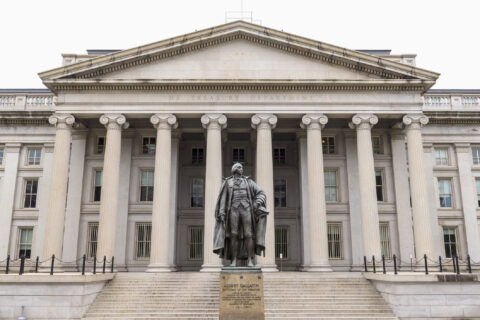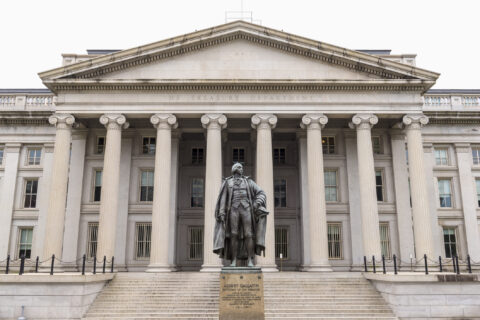President Biden and Speaker McCarthy reached a debt limit deal Memorial Day weekend, known as the Fiscal Responsibility Act of 2023. The legislation, H.R. 3746, passed the House on May 31 and the Senate on June 1. It is now on its way to the President’s desk. The legislation must be signed into law by June 5, also known as the Treasury’s “x-date,” to avoid a default on the national debt.
We break down the key provisions of this legislation that local leaders need to know below.
What is included in this deal?
Debt Limit Extended
A suspension of the debt ceiling until January 1, 2025. Congress will likely readdress this post-election 2024.
Spending Levels
The White House negotiators were able to keep the funding for fiscal year 2024 at current fiscal year 2023 funding levels. While there will not be an increase in year over year funding for non-defense discretionary spending, the $130 billion of cuts that Republicans initially proposed did not materialize. In fiscal year 2025, the non-defense discretionary is raised by one percent. After 2025, there are no budget caps. The deal also keeps in place clean energy funding and tax credits from the Inflation Reduction Act.
To pass the legislation in the Senate, Senate leadership agreed to reserve the right to pass emergency supplementals in the case of military readiness and emergencies such as natural disasters and fentanyl.
Unused COVID Relief Funds
This legislation rescinds some funds not yet used by federal agencies, also called “unobligated.” This does not include funds from the State and Local Fiscal Recovery Funds (SLFRF) program distributed to cities, towns and villages. These funds are safe, whether a city has already spent them or is still planning how to invest them in the community.
Work Requirements
The bill includes expanded work requirements for the Supplemental Nutrition Assistance Program (SNAP), formerly known as food stamps. Currently, adults ages 18-49 are limited to three months of SNAP benefits every three years unless they are working or in a work or training program at least 20 hours a week. Some individuals are exempt from this requirement, such as those who live with children in the household, those determined to be physically or mentally unfit for work, pregnant people, and others determined to be exempt from the three-month time limit. During the Public Health Emergency, (PHE), which ended on May 11th, these work requirements were suspended.
The additional work requirements included in the bill will phase in higher age limits for those work requirements, bringing the maximum age to 54 by 2025. The expanded work requirements have a sunset date of 2030. The new requirements also exempt those who are veterans, homeless or under 24 and aging out of the foster care system. The Congressional Budget Office estimates that a net of 78,000 new individuals will receive SNAP benefits even with expanded work requirements and that spending on SNAP will go up $2.1 billion (net) over ten years.
The bill also includes expanded work requirements for the Temporary Assistance for Needy Families (TANF) program in most states. TANF provides cash assistance to families with children and is designed and implemented at the state level. States are required to ensure 50% of TANF recipients are working, but states have the flexibility to reduce that threshold based on their caseload reduction as compared to 2005 levels. The bill passed by the House updates the comparison to 2015 levels, which means more states will have to increase their work requirements to meet this threshold. States can also lower their work participation rates by increasing their state contribution to the program.
Permitting Reform
Included in the bill is the BUILDER Act (H.R. 1577), which includes provisions to streamline the National Environmental Policy Act (NEPA), including:
- Codifying key elements of the One Federal Decision Framework, including development by the lead agency of a joint schedule, procedures to elevate delays or disputes, preparation of a single environmental impact statement and joint Record of Decision to the extent practicable.
- Setting deadlines for completion of NEPA review at one year for environmental assessments and two years for environmental impact statements, unless a deadline extension is agreed to by the project sponsor
- Establishing page limits for environmental documents and paper reduction measures—300 pages for complex projects and 150 pages for less complicated ones.
These are the same streamlining provisions that NLC has supported in the past.
The bill also modifieds NEPA to redefine the scope of environmental reviews to include “reasonably foreseeable environmental effects” of proposed agency actions and a “reasonable range” of alternatives to the proposed agency action.
Student Loan Debt Forgiveness
For municipal workers, the modifications made by the Biden Administration to allow more people working in government to qualify for Public Service Loan Forgiveness will not be rolled back. Additionally, the Administration’s plan to forgive up to $20,000 in debt for some student loan borrowers remains intact. A case is still pending before the Supreme Court on whether the Administration can forgive this debt.
What the deal does provide is that the Administration cannot further extend the pandemic-era freeze on student loan payments. The expiration of the pandemic emergency, which was the justification for the pauses, expired on May 11th.
What Happens Next?
On Thursday night, the legislation passed the Senate with bipartisan support by a vote of 63-36. The bill now goes to the President’s desk for signature.










